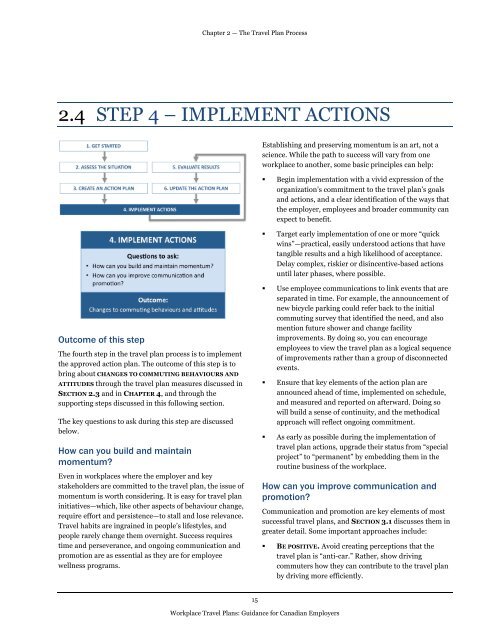Workplace Travel Plans - main body - Final Jan 2010 ENGLISH - FCM
Workplace Travel Plans - main body - Final Jan 2010 ENGLISH - FCM
Workplace Travel Plans - main body - Final Jan 2010 ENGLISH - FCM
Create successful ePaper yourself
Turn your PDF publications into a flip-book with our unique Google optimized e-Paper software.
Chapter 2 — The <strong>Travel</strong> Plan Process<br />
2.4 STEP 4 – IMPLEMENT ACTIONS<br />
Establishing and preserving momentum is an art, not a<br />
science. While the path to success will vary from one<br />
workplace to another, some basic principles can help:<br />
! Begin implementation with a vivid expression of the<br />
organization’s commitment to the travel plan’s goals<br />
and actions, and a clear identification of the ways that<br />
the employer, employees and broader community can<br />
expect to benefit.<br />
! Target early implementation of one or more “quick<br />
wins”—practical, easily understood actions that have<br />
tangible results and a high likelihood of acceptance.<br />
Delay complex, riskier or disincentive-based actions<br />
until later phases, where possible.<br />
Outcome of this step<br />
The fourth step in the travel plan process is to implement<br />
the approved action plan. The outcome of this step is to<br />
bring about CHANGES TO COMMUTING BEHAVIOURS AND<br />
ATTITUDES through the travel plan measures discussed in<br />
SECTION 2.3 and in CHAPTER 4, and through the<br />
supporting steps discussed in this following section.<br />
The key questions to ask during this step are discussed<br />
below.<br />
How can you build and <strong>main</strong>tain<br />
momentum?<br />
Even in workplaces where the employer and key<br />
stakeholders are committed to the travel plan, the issue of<br />
momentum is worth considering. It is easy for travel plan<br />
initiatives—which, like other aspects of behaviour change,<br />
require effort and persistence—to stall and lose relevance.<br />
<strong>Travel</strong> habits are ingrained in people’s lifestyles, and<br />
people rarely change them overnight. Success requires<br />
time and perseverance, and ongoing communication and<br />
promotion are as essential as they are for employee<br />
wellness programs.<br />
! Use employee communications to link events that are<br />
separated in time. For example, the announcement of<br />
new bicycle parking could refer back to the initial<br />
commuting survey that identified the need, and also<br />
mention future shower and change facility<br />
improvements. By doing so, you can encourage<br />
employees to view the travel plan as a logical sequence<br />
of improvements rather than a group of disconnected<br />
events.<br />
! Ensure that key elements of the action plan are<br />
announced ahead of time, implemented on schedule,<br />
and measured and reported on afterward. Doing so<br />
will build a sense of continuity, and the methodical<br />
approach will reflect ongoing commitment.<br />
! As early as possible during the implementation of<br />
travel plan actions, upgrade their status from “special<br />
project” to “permanent” by embedding them in the<br />
routine business of the workplace.<br />
How can you improve communication and<br />
promotion?<br />
Communication and promotion are key elements of most<br />
successful travel plans, and SECTION 3.1 discusses them in<br />
greater detail. Some important approaches include:<br />
! BE POSITIVE. Avoid creating perceptions that the<br />
travel plan is “anti-car.” Rather, show driving<br />
commuters how they can contribute to the travel plan<br />
by driving more efficiently.<br />
15<br />
<strong>Workplace</strong> <strong>Travel</strong> <strong>Plans</strong>: Guidance for Canadian Employers

















